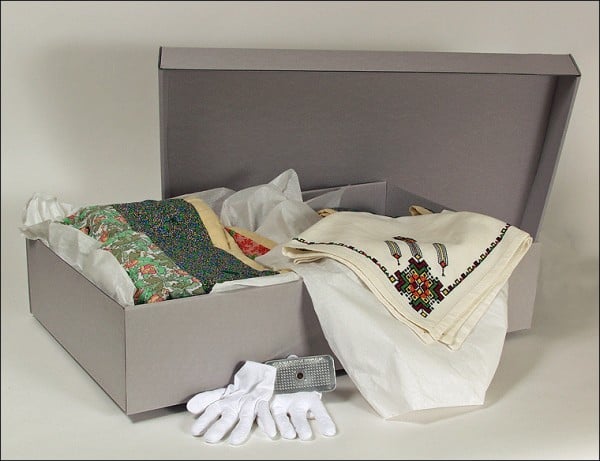
Storing quilts correctly is a very important thing to do, as quilts are a warm, tangible reminder of someone in your life. Perhaps yours was made by your mother, grandmother, or even your great-grandmother. Such heirloom quilts often have some special materials stitched into them, sometimes with an interesting story to tell (ask about these and write them down for future generations!). Many people keep their quilts on display, while for many others their quilts are sitting in some random box in an attic or basement—out of sight and out of mind. What many people don’t realize is that quilts, old and new, can easily be damaged or even completely ruined if not stored properly. With this in mind, please consider the following tips to help preserve your heirloom quilts, now and for the future.
Handle With Care
Although some quilts made of finer materials may seem more delicate than others, all are vulnerable to damage. Wear white cotton inspection gloves when handling your quilts. These gloves will protect the quilt from being stained by any lotions or naturally-occurring oils on your hands that may damage old, delicate material. Always remove jewelry before handling a quilt to prevent it from getting caught or snagged on the material, which might result in the quilt getting torn. When laying out your quilt always do so on a clean, dry surface and, as a general rule when it comes to family heirlooms / photographs / and artifacts, never eat or drink around a quilt as significant and perhaps permanent staining or damage is only a quick spill away.

Storing Quilts Properly
People often make a few common mistakes when it comes to storing their quilts. Many assume that a wooden or cedar chest is the ideal location for storing these textile heirlooms. This, however, is not the case. Over time wood can actually stain a quilt, leaving ugly brown spots that are difficult if not impossible to remove. Many individuals also store their quilts along with other items owned by an ancestor, with photographs and costume jewelry as possibly the most common examples. While the desire to organize and keep such artifacts together is, in principle, quite laudable, this is actually not a good idea. Photographs contain chemicals that can slowly damage quilts and other textiles, and old jewelry can tarnish or rust leaving stains. The rule-of-thumb, therefore, is “store quilts with other quilts and textiles / store photographs with other photographs / store artifacts such as jewelry with other artifacts.”

Best Practices for Storing Quilts
Rather than defaulting to using that old wooden chest that grandma used to store her quilts, consider just what it is that you are trying to accomplish. First and foremost, you want your quilt stored away from any damaging materials—the wood in grandma’s old chest, old vinyl garment bags, mothballs, other potentially damaging artifacts, etc.—that might come in contact with your quilt and either stain it or otherwise contaminate it with harmful chemicals. What you ideally want is an acid-free, compact, self-contained environment that will protect your quilt from dust, moisture, household contaminants, insects, too many things stacked on top of it, etc. The textile storage box is designed specifically for this purpose and is perfect for storing quilts properly. It is made from acid-free / lignin-free paper that will not contaminate nor damage the delicate materials that are in your quilt, all the while protecting it from various nasty threats.

Use Tissue Paper
Covering your quilt with archival tissue paper before you fold it for storage is highly recommended. When used this way, this tissue paper ends up between the folds of your quilt and adds extra protection by helping to support the material and reduce the likelihood of it becoming indelibly creased. It is also a good idea to refold your quilt a few times a year to prevent any permanent lines from forming at the creases. There are two types of archival tissue paper you can purchase for this purpose: buffered and unbuffered. The difference resides in the fact that buffered tissue contains, as its name implies, buffering agents that will help neutralize any acids that may be present, while unbuffered tissue does not contain these agents. If you are unsure of the materials in your quilt, or it contains silk or velvet, always use unbuffered tissue, which has a more neutral pH level.

Be Mindful of Moisture
Never store a quilt in a basement or attic, which are both prone to natural dampness and wide temperature and humidity fluctuations. There is also the additional dangers associated with flooding basements, either from natural causes or from a leaky water heater, and from leaky roofs in the attic. Nothing short of a fire can be more potentially damaging to heirloom quilts than excess moisture and the staining, mold growth and other unpleasantries that come with it.

(Please click on image for more information.)
All-In-One Solutions
If you are looking for an all-in-one solution for storing your quilts then the Textile Storage Kit is the perfect answer (see above). These kits come with two pairs of white cotton inspection gloves, an acid-free textile storage box, a package of 24 inch x 20 feet un-buffered archival tissue, a reusable metal desiccant canister that helps keep textiles dry, and a large archivally-safe polyethylene bag that can help protect the entire box from getting wet. Simply follow the tips above, along with the simple instructions that come with the Textile Storage Kit, and then store your quilt in a cool, dark place such as an indoor closet. Your treasured heirloom will stay safe and protected for generations to come!
Contact Us
If you have any additional questions or would like more information on the archival storage and presentation materials that are right for you, please contact us here at Archival Methods. We’re always there to help with any archiving, storage, or presentation questions you may have.
